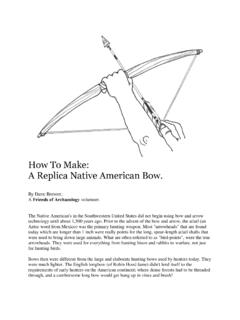Transcription of ARCHAEOLOGY OF A GREAT WAR DUGOUT: BEECHAM FARM ...
1 ARCHAEOLOGY OF A GREAT WAR dugout : BEECHAM farm , passchendaele , BELGIUMPETER DOYLE, PETER BARTON, AND JOHAN VANDEWALLEA BEECHAM dugout is situated on the lower slopes of the passchendaele Ridge, to thenorth-east of the Belgian town of Ypres (Ieper). Fears over the stability of the struc-ture created the need for emergency archaeological investigations. The dugout is shal-low (2 m deep) and was constructed in a basic T shape, with accommodation for66 men and four officers. It is cut within silty-sand levels of the passchendaele dug-out was surveyed, recorded and removed. Archival studies, coupled withartefacts recovered, suggest that this is a dugout of German construction, but onethat had been occupied by British troops after capture of the ridge in 1917. Prior tothis discovery, the presence of German dugouts was GREAT War of 1914 1918 was largely static: a fortress war that bearscomparison with the siege warfare prevalent centuries before.
2 The descentinto a conflict of entrenchments and earthworks along the Western Frontdeveloped at the end of 1914, and largely continued in a state of mutualsiege until the final breakthroughs of 1918. For almost four years, the armiesof the Western Front endured a troglodyte existence, as artillerymen vied withengineers to weaken the line and provide opportunities for advance. Under-standing the ground was an important task in the development of this under-ground war, and a sophisticated science of ground engineering was deployedin its development. The nature and practical aspects of the field fortificationsthemselves have been reviewed in several papers and books ( Brooks 1920;Imperial War Museum 1997; 1998; Doyle and Bennett 1997; Doyle 1999;Doyleet ; 2001). However, thus far, few archaeological studies haveconsidered the engineering conditions and construction of underground exca-vations in Flanders, particularly within the Ypres Salient, in which the frontlines partially enclosed the Belgian town of Ypres (now Ieper) from late 1914onwards.
3 The purpose of this paper is to describe a systematic study of onesuch dugout in the Salient, of uncertain opportunity to undertake a comprehensive study of a mined dugoutarose in 1999 when a crownhole revealed a well-preserved dugout in frontof a farm BEECHAM farm on contemporary trench maps between Zonnebekeand passchendaele . The dugout was surveyed, its structure accurately recorded,JCA, 15072_F4_45-66 6/24/05 2:38 AM Page 45and the artefacts and a large percentage of the timbers rescued before reme-dial works necessary to ensure the future integrity of the farm were carriedout (Bostyn 1999; Doyle 2001; Doyle et ; Barton et al. 2004). Thepurpose of this paper is therefore to present a detailed account of the excavationand remediation of this important relic of the underground war on the Ypres Salient, 1914 1918 The Ypres Salient was the name given to the arc of trench systems sur-rounding the Belgian city of Ypres (Fig.)
4 1). Today this city is known by itsFlemish name of Ieper, but to the British, French and German armies of theGreat War it was Ypres, and this convention is used in the present profile of the Salient followed an almost continuous line of low ridgesthat enclosed the town on three sides. Of these, the most dominant was thePasschendaele Ridge that lies to the north east of Ypres. The town lieseffectively in the centre of a shallow bowl, the elevated rim of which was ofimmense tactical importance to the passchendaele Ridge barely rises above a height of ca. 50 m, but itscapture early in the war by German forces provided an opportunity to observethe day-to-day activities of the Allied armies, essential in a war dominated byartillery and the need for accurate and continuous observation. The First andSecond Battles of Ypres (October November 1914 and April May 1915) estab-lished the Germans in commanding positions on all the ridges, includingPasschendaele.
5 Following these battles they consolidated their positions by con-structing several lines of defence-in-depth, the Flandern Stellung, which includedextensive concrete fortifications in the form of MEBU (Mannschafts EisenbetonUnterstande): pill boxes intended to provide mutually supporting fields of fire(Oldham 1995). These were widespread and concentrated long before theThird Battle of Ypres ( July November 1917), which was a largely Britishoffensive intended to drive the Germans from their commanding positionsand break out into open country beyond the Salient, and thence to Zeebruggeand Ostend. Although the final objectives of the campaign were not met, thePasschendaele ridge was finally captured in November 1917. These positionswere later abandoned in the face of the German Kaiserschlacht offensive ofSpring 1918, but recaptured during the final advance to victory by the Alliesin the summer of 1918.
6 Accounts of the British operations in the Salient maybe consulted in the numerous volumes of the British Official History, MilitaryOperations, France and belgium , issued mostly by HMSO between 1925 and DOYLE, PETER BARTON, AND JOHAN VANDEWALLEJCA, 15072_F4_45-66 6/24/05 2:38 AM Page 46 ARCHAEOLOGY OF A GREAT WAR DUGOUT47 Fig. 1. The Ypres Salient, showing the position of the BEECHAM dugout relative to thePasschendaele RidgeJCA, 15072_F4_45-66 6/24/05 2:38 AM Page 47 Geological conditions of the SalientThe development of the Ypres Salient was partially influenced by its geol-ogy, which asserts a distinct control on a relatively simple landscape, and wasto influence directly field engineering ( Johnson 1921; Doyle and Bennett 1997;Doyle 1999; Doyle et al. 2000).Ypres was mapped geologically at the turn of the 20th century, using asimple division into Ypresian (Y) and Paniselian (P) militarygeologists also mapped the region using a scheme that classified the geologyon suitability for dugout construction,2defined on its water-bearing charac-teristics ( Ball 1919; King 1919; Institution of Royal Engineers 1922a).
7 The Paniselian was of particular concern (Doyle et ). A sketch mapof the BEECHAM area, based on these data, is given in Fig. in the Ypres SalientDuring the GREAT War, the term dugout was commonly used for a vari-ety of shelters, including surface constructions. For the purpose of this paper,we are restricting it to sub-surface shelters intended for habitation, developedas a protection against shellfire. Three basic dugout types can be recognised:shallow supported recesses ( funk holes ) cut into the walls of the trench, giv-ing limited protection; cut-and-cover shelters, roofed with timbers, corrugatediron sheeting ( elephant iron ) and sand bags, giving some protection fromindirect artillery fire (shrapnel bullets and shell fragments); and deep mineddugouts with overhead cover which were proof against most artillery, depen-dent upon its calibre (Brooks 1920; Doyle and Bennett 1997; Doyle 1999;Doyle et ; Barton et ).
8 Deep mined dugouts, the type most desired by the troops, were intendedto withstand direct hits, and therefore needed adequate head cover, sufficientdepth of earth and other material between dugout roof and the surface toarrest the progress and detonation of the shell at a point where the dugoutwould remain undamaged (Brooks 1920; Royal Engineers 1925; Barton et ). German engineers were first to realise the potential of deep dugouts;it was not until October 1916 that the British Army began standardisation ofdesign, and within two months dimensions, overall design, general size and48 PETER DOYLE, PETER BARTON, AND JOHAN VANDEWALLE1 Commission G ologique de Belgique 1897 1:40,000 Carte G ologique de Belgique, No. 81 Poperinghe-Ypres, and 1:40,000 Carte G ologique de Belgique, No. 82 Gheluvelt-Moorseele. InstitutCartographique Militaire: Brussels. Geological Society , 1:10,000, Sheet 28 NE1 (Geological).
9 Ordnance Survey: Southampton, November1917. National Archives, Kew, WO297/2470).JCA, 15072_F4_45-66 6/24/05 2:38 AM Page 48 ARCHAEOLOGY OF A GREAT WAR DUGOUT49arrangement of galleries, ventilation, etc had all been standardised. Therewere between 8 10 model types; the Inspector of Mines, Colonel , , was to state that: there is no reason why deep dugouts shouldnot be as completely and as advantageously standardised as huts .3 Factors controlling construction and depthDoyle et al.(2001) outlined four factors that may be considered significantin the construction of deep dugouts, namely: water table and its fluctuation;geotechnical characteristics of the soils, particularly with regard to wall androof stability; ability of the soils to prevent deep shell penetration; and theintended use for the dugout and its position relative to the , Assistant Inspector of Mines, Visit Diary [1916] National Archives, Kew,WO 158/137 Fig.
10 2. Sketch geological map of the BEECHAM farm area based on contemporary Britishmilitary maps and boreholes, showing known dugoutsJCA, 15072_F4_45-66 6/24/05 2:38 AM Page 49 Water table and geotechnical characteristicsIn Flanders, a thick deposit (100 m) of Ypres Clay (Kortrijk Formationin mod-ern accounts) acts as an aquiclude, leaving the overlying sands often saturatedwith water percolating from ground level. Ultimately, this prevented the devel-opment of extensive dugout galleries or mines without special revetment (King1919; Institution of Royal Engineers 1922a). A series of special geologicalmaps were produced by the British, based largely on the extensive boreholes4indicated that successful deep dugouts could only be excavated in the YpresClay. This clay is relatively stiff(Verret 1980), and produces the firm groundoptimum for tunnelling, although field experience of dugout excavation demon-strated that swelling of the clays did periodically occur away from its moreheterogeneous top, crushing and bursting supporting timbers (Institution ofRoyal Engineers 1922a: 40).




